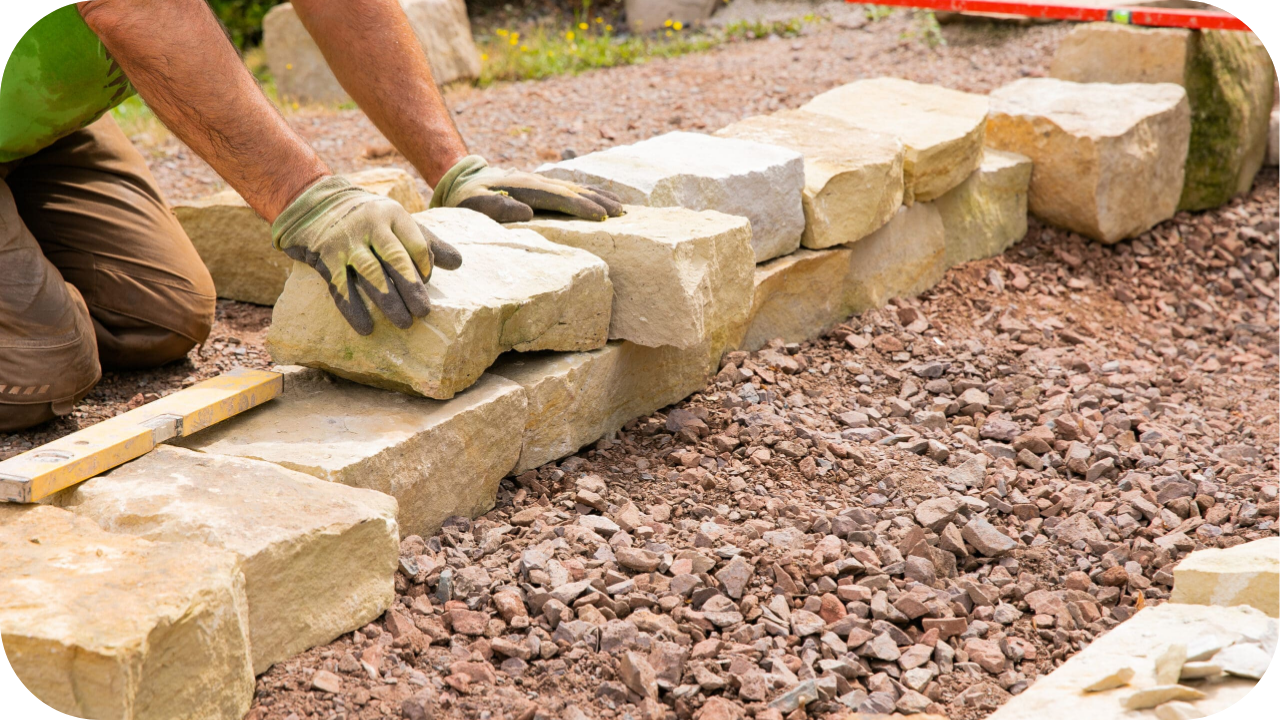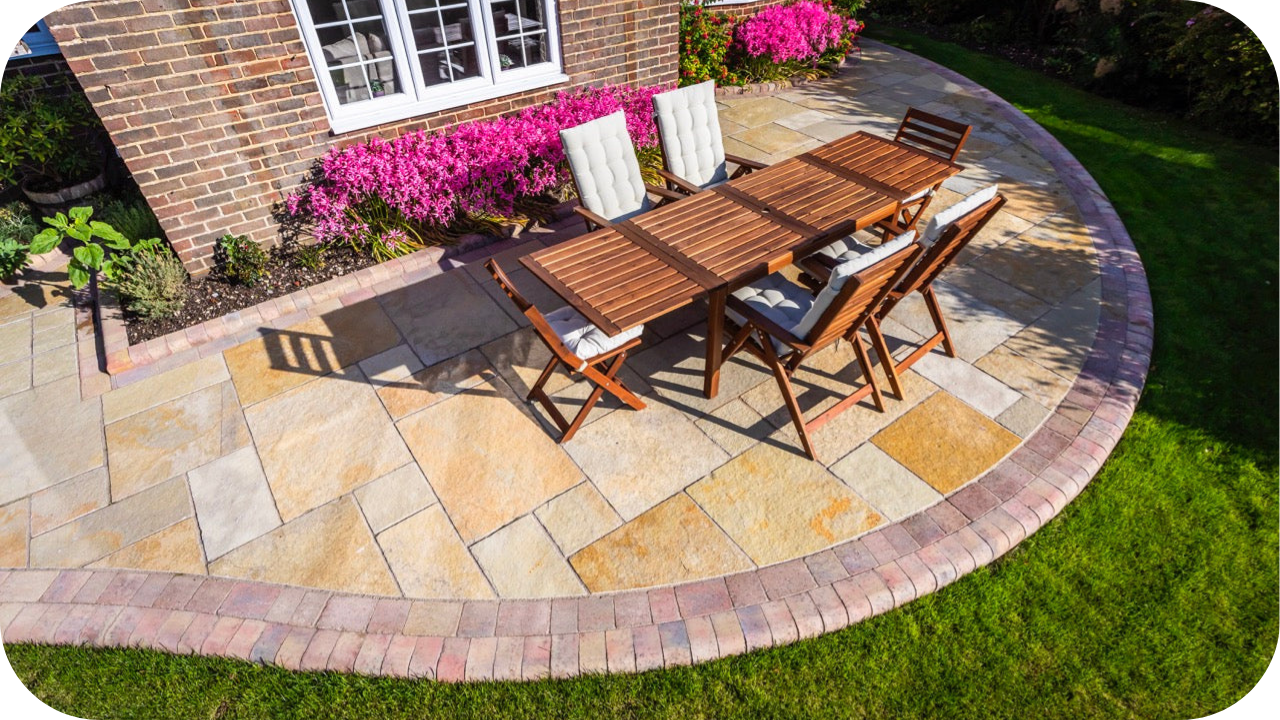
Planning a DIY natural stone project for your Melbourne property? Natural stone adds beauty and value, but it’s crucial to prioritise safety and get it right.
Before laying the first stone, are you aware of common mistakes that could jeopardise your project and safety?
Don’t risk it. This guide highlights the top DIY natural stone blunders to avoid, helping you create a stunning and secure stone feature.
1. Not Choosing the Right Type of Stone for the Project
One of the most common mistakes is selecting the wrong type of natural stone for the intended application. Softer, more porous stones like marble and limestone, while beautiful, are vulnerable to scratches, staining, and etching, making them less ideal for high-traffic areas, kitchens, or bathrooms without meticulous sealing and maintenance.
Conversely, highly durable options like granite and quartzite, while resistant to damage, can present challenges during fabrication and installation due to their hardness. Consider the specific demands of your project. Will it be exposed to moisture, heavy foot traffic, or acidic substances?
Research each stone’s properties, including its durability (scratch resistance), porosity (stain susceptibility), and required maintenance (sealing frequency). Consulting with a stone professional is highly recommended to ensure the chosen material aligns perfectly with the project’s requirements and longevity goals.
2. Improper Surface Preparation

Failing to adequately prepare the substrate can result in a host of problems, including uneven surfaces, cracking, shifting, and ultimately, costly repairs. Natural stone, regardless of whether it’s used for tiles, countertops, or pavers, demands a stable, level, and properly supported base.
The subfloor must be thoroughly cleaned, free of debris, and completely dry for interior applications like tile or countertop installations. Any existing imperfections must be addressed to ensure a flat plane.
Furthermore, the subfloor’s structural integrity must be assessed to ensure it can bear the considerable weight of the stone. For exterior applications like patios or walkways, the foundation or base needs similar attention.
It must be compacted, level, and potentially reinforced to prevent settling or shifting over time. Ignoring these crucial preparatory steps compromises the entire installation and can lead to significant structural issues down the line.
3. Using the Wrong Adhesive or Mortar
A common mistake is using generic, all-purpose mortars or adhesives that are not formulated for the specific properties of natural stone. Standard cement-based mortars, for example, may not adhere properly to certain stone types, leading to loose tiles or slabs.
Furthermore, some mortars can react with the minerals in the stone, causing unsightly staining or discolouration. It’s imperative to use high-quality, specialized thin-set mortars or adhesives specifically designed for natural stone.
These products offer superior bonding strength and are formulated to minimize the risk of staining. For light-coloured stones like marble or travertine, white thin-set mortar is essential to prevent any discolouration or darkening of the stone.
Consult with a stone professional or the adhesive manufacturer to determine the most appropriate product for your specific stone type and application. Using the wrong adhesive not only compromises the installation’s integrity but can also permanently damage the stone itself.
4. Ignoring Proper Sealing Techniques

Many types of natural stone, such as marble, limestone, and travertine, are naturally porous and require sealing to protect them from moisture absorption, stains, and long-term deterioration.
Without an appropriate sealant, the stone can easily absorb liquids, leading to discolouration, weakening, and even mould growth in high-moisture areas like bathrooms and outdoor spaces.
A common mistake is applying a subpar or incorrect sealant that does not provide adequate protection. For example, using a topical sealer instead of a penetrating sealer on a highly porous stone can create a surface layer that wears off quickly, leaving the stone vulnerable to stains and water infiltration.
Conversely, failing to seal at all can cause irreversible damage, particularly in outdoor installations where exposure to rain, UV rays, and dirt accelerates degradation.
Sealing should be done in multiple stages: first, before grouting to prevent grout residue from seeping into the stone’s pores, and again after installation to enhance its durability. Regular maintenance is crucial, as sealants wear down over time.
High-traffic areas, kitchen countertops, and outdoor installations may require resealing every six to twelve months, while less-exposed surfaces can be resealed every two to three years. Conducting a water droplet test—where water is sprinkled on the stone to see if it beads up or soaks in—can help determine when resealing is necessary.
5. Incorrect Cutting and Handling

Precision is key when cutting natural stone, as improper techniques can lead to chipping, jagged edges, or even complete breakage. One of the most common mistakes is using an inappropriate saw blade.
Standard masonry blades can cause rough, uneven cuts, whereas wet saws with diamond-tipped blades are specifically designed to slice through stone smoothly while minimising dust and heat buildup. A wet cutting process reduces friction, keeping the stone intact and preventing micro-cracks that can weaken it over time.
In addition to cutting mistakes, improper handling is another major issue. Natural stone slabs and tiles are heavy and brittle, making them susceptible to damage if not stored or transported correctly. Carrying large slabs flat instead of upright can lead to stress fractures, and dropping even a small piece can cause chips or cracks.
Protective padding should be used during transportation, and tiles should be stacked vertically with spacers to prevent pressure points that could cause breakage.
6. Improper Grouting and Cleaning Methods

Grouting and cleaning are crucial final steps in natural stone installation, and improper techniques can significantly impact the stone’s appearance and longevity. Choosing the wrong grout type is a common pitfall.
For instance, sanded grout, while suitable for some applications, can easily scratch the polished surface of delicate stones like marble or granite. Unsanded grout is often preferred for these smoother surfaces.
Furthermore, the grout’s colour should complement the stone. Beyond grout selection, the application process itself is critical. Overuse of water during cleanup can weaken the grout, leading to discolouration, efflorescence (a white powdery substance), or even cracking.
It can also allow water to penetrate the stone, potentially causing staining or other moisture-related problems. Always adhere to the manufacturer’s instructions for grout application, including proper mixing ratios and curing times.
Use appropriate cleaning methods, avoiding harsh chemicals or abrasive pads that can damage the stone or the grout. Regular cleaning with a pH-neutral cleaner designed for natural stone is recommended to maintain its beauty and prevent the buildup of dirt and grime.
7. Neglecting Expansion Joints
Natural stone, like most materials, experiences expansion and contraction with temperature fluctuations. Neglecting to incorporate expansion joints during installation can lead to significant problems, including cracking, lifting, or warping of the stone.
These joints, strategically placed gaps between stone sections, allow for this natural movement without putting stress on the stones themselves. They are particularly crucial in large installations like floors, patios, and walls, and in areas with significant temperature variations.
The size and spacing of expansion joints will depend on the type of stone, the size of the installation, and the local climate. Consulting with a professional installer is essential to determine the appropriate placement and size of these critical joints.
8. Overlooking Drainage and Water Exposure

Proper drainage is paramount for exterior natural stone installations. Failing to address water runoff can lead to a host of issues, from erosion and staining to more serious problems like frost damage in colder climates.
Water pooling around the base of stone installations can also weaken the supporting structure. Simply placing stones directly on soil is insufficient and will likely lead to premature wear and tear.
For patios and walkways, a slight slope is essential to facilitate water runoff away from the structure. Appropriate underlayment, such as a well-draining base material, is also crucial to prevent moisture retention beneath the stones. This prevents water from seeping into the stone and causing staining or damage.
9. Skipping a Test Sample Before Installation
Natural stone, even within the same batch, can exhibit variations in colour, veining, and texture. Failing to lay out a test section before full installation can result in an inconsistent and visually jarring appearance, especially with patterned or veined stones.
Taking the time to arrange a few pieces in the intended layout allows you to preview the overall aesthetic and make adjustments as needed.
This is particularly important for complex patterns or when trying to achieve a specific visual flow. This simple step can prevent costly rework and ensure a cohesive and aesthetically pleasing final result.
10. Failing to Maintain the Stone Properly

A common misconception is that natural stone requires no maintenance. In reality, neglecting proper care can lead to staining, etching, and eventual deterioration of the stone’s surface. Many common household cleaners, particularly those with acidic components like vinegar or lemon juice, can damage certain stones like marble and limestone.
These acids can etch the surface, leaving dull spots or even removing the polish altogether. Always use pH-neutral cleaners specifically formulated for natural stone.
Regular sealing, as recommended by the stone manufacturer, is also essential to protect the stone from stains and moisture. This protective sealant creates a barrier that repels liquids and helps maintain the stone’s beauty for years to come.
Conclusion
Don’t let these common mistakes ruin your dream natural stone project! Proper planning and execution are key to a lasting and beautiful result. Before you begin, thoroughly research your chosen stone’s properties and consult with experienced professionals.
Contact a qualified stone fabricator or installer today for expert advice and guidance tailored to your specific project needs. Start your project the right way with Splendour In Stone!
More To Explore

How Can I Achieve a Coastal Vibe with Beachport Quartz?
Coastal design evokes calm, openness, and a strong connection to nature, making it a favourite across many Australian homes. Achieving this look begins with the

Best Natural Stone Paving Options in Victoria
Outdoor living has become a way of life in Victoria — from sunlit patios in regional retreats to sleek courtyards in urban Melbourne. With this


